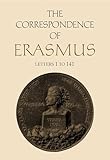The Correspondence of Erasmus : Letters 1-141, Volume 1 / Desiderius Erasmus.
Material type: TextSeries: Collected Works of Erasmus ; 1Publisher: Toronto : University of Toronto Press, [2002]Copyright date: ©1974Description: 1 online resource (416 p.)Content type:
TextSeries: Collected Works of Erasmus ; 1Publisher: Toronto : University of Toronto Press, [2002]Copyright date: ©1974Description: 1 online resource (416 p.)Content type: - 9780802019813
- 9781442680937
- 199/.492
- PA8511.A5
- online - DeGruyter
| Item type | Current library | Call number | URL | Status | Notes | Barcode | |
|---|---|---|---|---|---|---|---|
 eBook
eBook
|
Biblioteca "Angelicum" Pont. Univ. S.Tommaso d'Aquino Nuvola online | online - DeGruyter (Browse shelf(Opens below)) | Online access | Not for loan (Accesso limitato) | Accesso per gli utenti autorizzati / Access for authorized users | (dgr)9781442680937 |
Browsing Biblioteca "Angelicum" Pont. Univ. S.Tommaso d'Aquino shelves, Shelving location: Nuvola online Close shelf browser (Hides shelf browser)

|

|

|

|

|

|

|
||
| online - DeGruyter The Contested Past : Reading Canada's History - Selections from the Canadian Historical Review / | online - DeGruyter The Conventional Man : The Diaries of Ontario Chief Justice Robert A. Harrison, 1856-1878 / | online - DeGruyter The Correspondence of Erasmus : Letters 1122 to 1251, Volume 8 / | online - DeGruyter The Correspondence of Erasmus : Letters 1-141, Volume 1 / | online - DeGruyter The Correspondence of Erasmus : Letters 1252 to 1355, Volume 9 / | online - DeGruyter The Correspondence of Erasmus : Letters 1356 to 1534, Volume 10 / | online - DeGruyter The Correspondence of Erasmus : Letters 142 to 297, Volume 2 / |
restricted access online access with authorization star
http://purl.org/coar/access_right/c_16ec
The correspondence of Erasmus has never been completely translated into English, although it has long been acknowledged to be one of the most illuminating sources for the history of northern humanism and the first two decades of the Protestant Reformation. In his letters, to and from scholars and religions leaders, printers and patrons, princes and prelates in every country of western Europe, the interests and issues of that critical era found free expression. They are connected by the thread of Erasmus' personal experience, his joys and sorrows, triumphs and tribulations, and his uninhibited conversation with his friends.Erasmus himself regarded his letters as a form of literature, and they were valued in his time, as they are now, as much for their style as for their content. In The Study of Good Letters (Clarendon 1963), H.W. Garrod wrote: 'As a document of the history of the times the Letters have primary importance. Yet they ar to be valued, ultimately, not as they enable us to place Erasmus in history, but as they help us to disengage him from it, to redeem him out of history into literature, placing him where, in truth, he longed to be. Not the Folly nor the Colloquies but the Letters, are his best piece of literature. What he did in scholarship, whether biblical, patristic, or classical has been superseded - though not the fine temper of it. That fine free temper shines also in the Letters, being indeed one of the elements of literature? In the immortality of their readableness Erasmus lives securely, immune from the discredits of circumstances.'The volume of the correspondence is enormous, and its cumulative effect fully justifies the claims that have been made for its importance. Erasmus was from his youth on an indefatigable correspondent, although he was careless about preserving his own letters or those written to him until he became famous and found printers eager to publish them. As a consequence, 85 per cent of the surviving letters were written after he reached the age of forty-five. Even when he had no thought of publication, however, he strove ceaselessly to make his letters models of elegant classical latinity, while adjusting the style of each letter to fit its purpose, content, and recipient. Even the earliest letters of volume 1 bear evidence of this concern. This volume includes a number of youthful rhetorical attempts, letters describing his early vicissitudes as he struggled to maintain himself as a scholar, letters to friends and letters about enemies, letters to patrons and prospective patrons, and the beginnings of the more serious intellectual correspondence of his later years in an exchange of letters with John Colet on the subject of Christ's agony.
Mode of access: Internet via World Wide Web.
In English.
Description based on online resource; title from PDF title page (publisher's Web site, viewed 01. Nov 2023)


